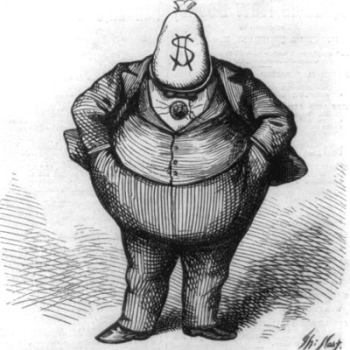What's the best yardstick for measuring a typical American's income?
Sifting through the online publications of various government agencies I find two very different measurements frequently used. One is the per capita personal income. (Figures for 2002 are on page 6 of this .pdf file from the Bureau of Economic Analysis.) For the country as a whole, per capita income was $30,941 in 2002. By state, Connecticut was the wealthiest at $42,706 and Mississippi was the poorest, at $22,372.
Eligibility for some government assistance programs is determined by threshholds based on "median family income." This is a median, not a mean like the figures above, and its for a family of four — which means it accounts for many families with more than one income. See this page from LIHEAP for recent figures. By this measure, the wealthiest state is New Jersey, with a median family income of $82,406. The poorest state is West Virginia at $47,550.
In the newspaper biz, we're constantly running articles — especially in the business and personal finance pages — that toss out hypothetical income figures: "Jim is making $70,000 a year and wants to invest $15,000 for retirement."
Several of my bosses will read that and think, "Poor Jim. How can he hope to save for retirement on only $70,000 a year?" My initial response — which I'm guessing is more typical of most of our readers — is "Jim, you lucky bastard, you're buying the next round."
Or consider this AP story on teachers' pay that was on the wires last week.
The average teacher makes a lot more than I do, but I don't begrudge them that. Considering the importance of their profession I think they're probably underpaid.
Yet the tone of the piece — based on a study by the American Federation of Teachers — seemed to be seeking pity from readers who may not have been doing nearly as well themselves. I suspect that the average teachers' income for last year — $45,771 — prompted at least as much envy as pity from readers. But this isn't obvious from the measurements above. Judging from per capita income, the typical teacher seems to be doing quite well. Looking at the median household incomes though shows that a family of four with a teacher as the sole breadwinner is definitely not keeping up with the Joneses.
The AP/AFT article goes on to explain that this average is skewed a bit by a graying population of teachers — people with lots of seniority throw off the average. The more important figure thus might be the average income of those just starting as teachers, which was $29,564 — and factor in against that the increasing cost of student loans.
Overall, most teachers saw their wages increase 3.3 percent last year, but had the cost of their health insurance increase by more than that, thereby eating up their raise and then some. (I think most of our readers can relate to that all too well.)
Even in California, where teachers average a national-high $55,693, educators will have a hard time relating to the struggles of hypothetical investors like "Jim."
So again I ask, what's the best yardstick for measuring a typical American's income?
And, given such a measurement, what's the best way to help the media to get a clue about the real incomes of real people in the real world?












